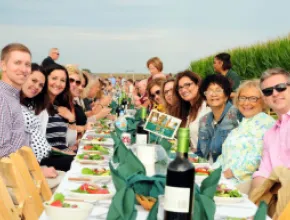Staff reductions, pay cuts, budget bludgeoning, increased workloads--you know the story.
So where is the joy at ACME Inc. these days? A lot of it, ironically, can be found in team building. In fact, an argument could be made that there is a need for team-building events and exercises now more than ever.
In what is currently perceived to be a struggling if not stagnant economy in some quarters, employee and yes, even management morale, can be counted among the collateral damage.
A valued natural element of team building is that it can tap into some of our earliest feelings of fun, excitement and socialization, echoing back to when we were kids. Indeed, some of the early team-building exercises and events included puzzles, board games, magic tricks and other fundamentals employing creativity and imagination, including such ubiquitous toys as Legos and erector sets.
During these early social interactions, natural leaders tended to emerge along with others who displayed cooperation and ingenuity, or lack thereof. Personalities began to emerge and heretofore hidden traits bubbled to the surface, all in a very organic way.
Today's corporate team-building events, exercises and activities provide many of these same benefits and values with regard to stimulating motivation, improving communication, building trust and fostering a better understanding of and appreciation for colleagues.
Communication is, and has always been, an essential component of successful teamwork and is especially important in times of economic uncertainty and workplace reorganization and restructuring.
Informed employees, whether in the corner offices or on the shop floor, feel more confident, secure and empowered if they feel they are being kept in the loop. And empowered teams historically generate the best results, as they are functioning as a group in a culture of inclusion where there is encouragement to look out for each other and to succeed and enjoy themselves while doing it. This can move mountains.
Hotels and resorts employ trained professionals who are fluent in not only their specific venue, but also can act as a concierge for their hometown. To maximize and enrich a team-building exercise, the hotel experts should understand and know well the culture of the resort and the sociological makeup of the market surrounding the property.
Cooking Camaraderie
Chefs can often play an important role in team-building exercises. Virtually every hotel and resort has one and his or her experience and expertise can make for interesting and engaging classes in menu planning and meal creation and execution. These culinary contests and competitions can include elements of the culture and the environment where the resort is located, be it in recipe elements and/or presentations--all researched and organized by team members. This process allows for a little education and a heightened awareness of something new beyond their corporate culture and hometown. Each resort provides a setting and a culture to be explored, whether urban, suburban or rural.
Suburban and rural resort locations can offer more outdoor activities for team-building prospects that include obstacle courses, scavenger hunts, baseball, flag football and relay races.
Golfing competitions have historically offered defining moments of character and cooperation, especially with “best ball” tournaments. These kinds of physical events promote more than team dynamics, as the physical exercise can offer stress reduction and endorphin release. My property, Hyatt Regency Tamaya Resort & Spa, takes physical competition a step further by offering rodeo events for everything from beginners to experienced equestrians.
Motivation can often be optimized by involving participants in the decision-making process regarding what kind of activities will be put in play and how they will be designed and executed There are some participants who may have special expertise and interests to share and around which to build great team activities. In the teams selection process it is often best to separate cubicle mates. And some people are not comfortable being on the same team or in a group along with their boss or direct reports in either direction.
Sometimes, as part of the mix, the team can be asked what type of team-building activity they would prefer. Most team-building facilitators do this, but if you haven't it's a good idea to mix up the teams from time to time, unannounced or unexpectedly, to show how team dynamics and behaviors can change, along with the effects of doing so. Although the structure of the game remains the same, players often react in very different ways as the order and hierarchy is altered.
And to this point, also observe how games are affected if the number of participants is changed. Larger teams require leadership. Who will emerge as the leader and who as passengers? You can play the
same game with three or six people and it can totally alter the conduct and outcomes. Changes can also come in the form of gender and age mixes, and as such are crucial to providing an understanding and appreciation of the differences, and to demonstrate how working together can transcend them.
These types of team-building exercises are very relevant today as many employees are being offered, and accepting, early retirement, while others are laid off. The remaining employees are suddenly faced with major shifts and changes in departmental line-ups, and the resultant dynamics can alter the mood and outcome of that team’s output and quality of work.
At its core, and essence, the empowerment of people is more about attitude and behavior toward staff, up and down the line, than process and tools.
Do your homework and choose wisely the types of events and activities that best suit your goals, needs and budget. Today more than ever, team building has to be value-conscious, cost-efficient and effective, and memorable. You'll want your participants talking at the water cooler with new purpose, focus and appreciation for their colleagues and speculating on where and how much fun the next one will be.
Steve DeFelice is the director of sales and marketing for the Hyatt Regency Tamaya Resort & Spa, located between Albuquerque and Santa Fe, New Mexico.





